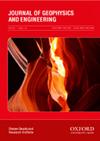Azimuthal seismic reflection characteristics with quality factor Q in viscoelastic horizontal transverse isotropic media
IF 1.7
3区 地球科学
Q3 GEOCHEMISTRY & GEOPHYSICS
引用次数: 0
Abstract
In seismic exploration, a precise description of the seismic reflection property is critical for reservoir prediction and fluid identification. In the study of seismic wave transmission effects, taking into account both the viscoelastic and anisotropic properties of a medium is compatible with the features of the earth. Moreover, it is advantageous to the characterization of complicated reservoirs. According to the elastic medium foundation and the imaginary component with quality factor Q, seismic reflection properties of viscoelastic media are described in the complex domain. The complex wave number is expressed by phase velocity and Q. The attenuation angle is introduced when the complex wave number is represented by a propagation vector and an attenuation vector. The exact velocity and polarization direction of a viscoelastic medium are expressed using a complex stiffness matrix incorporating Q matrix elements. The quasi-Zoeppritz equation for viscoelastic horizontal transverse isotropic (VHTI) media is derived by using boundary conditions based on the wave function of viscoelastic media. The numerical simulation of reflectivity reveals that the reflection coefficient in a viscoelastic medium is clearly different from that of an elastic medium. Moreover, the difference in reflection coefficient in various orientations has distinct characteristics.粘弹性水平横向各向同性介质中具有品质因子Q的方位地震反射特征
在地震勘探中,准确描述地震反射性质对储层预测和流体识别至关重要。在地震波传播效应的研究中,同时考虑介质的粘弹性和各向异性是符合地球特性的。此外,它还有利于复杂储层的表征。根据弹性介质基础和具有品质因子Q的虚分量,描述了粘弹性介质在复域中的地震反射特性。复波数用相速度和q表示,当复波数用传播矢量和衰减矢量表示时,引入衰减角。用含有Q矩阵元的复刚度矩阵表示粘弹性介质的精确速度和极化方向。基于粘弹性介质的波函数,利用边界条件导出粘弹性水平横向各向同性介质的准zoeppritz方程。反射率的数值模拟表明,粘弹性介质中的反射系数与弹性介质中的反射系数有明显的不同。不同方位反射系数的差异具有明显的特点。
本文章由计算机程序翻译,如有差异,请以英文原文为准。
求助全文
约1分钟内获得全文
求助全文
来源期刊

Journal of Geophysics and Engineering
工程技术-地球化学与地球物理
CiteScore
2.50
自引率
21.40%
发文量
87
审稿时长
4 months
期刊介绍:
Journal of Geophysics and Engineering aims to promote research and developments in geophysics and related areas of engineering. It has a predominantly applied science and engineering focus, but solicits and accepts high-quality contributions in all earth-physics disciplines, including geodynamics, natural and controlled-source seismology, oil, gas and mineral exploration, petrophysics and reservoir geophysics. The journal covers those aspects of engineering that are closely related to geophysics, or on the targets and problems that geophysics addresses. Typically, this is engineering focused on the subsurface, particularly petroleum engineering, rock mechanics, geophysical software engineering, drilling technology, remote sensing, instrumentation and sensor design.
 求助内容:
求助内容: 应助结果提醒方式:
应助结果提醒方式:


